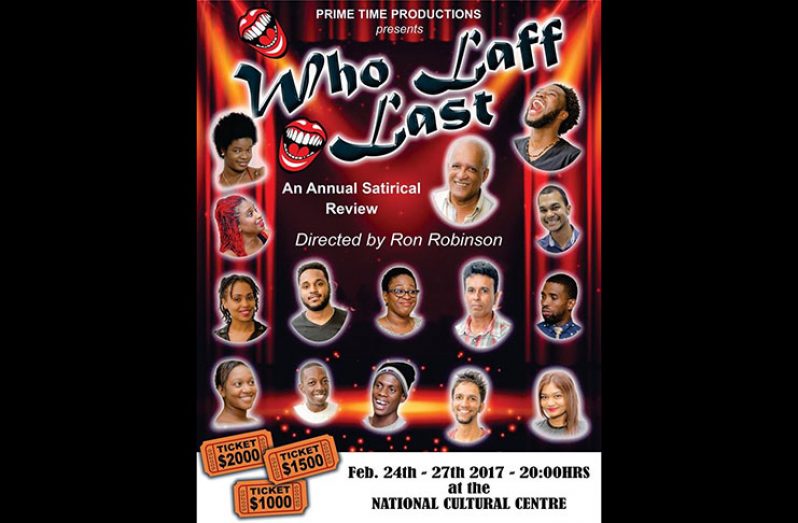Satire has always held an important position in drama, and it is one of the forms of theatre that is very successful in Guyana. Indeed, while other types of drama fade in and fade out as often as the moon waxes and wanes, comedy, particularly satire, continues to dominate the local theatrical landscape. Of course, a lot of it has to do with our society which, with all its misery is ripe for the potential for comedy. While that sentence might seem like a paradoxical statement, it is actually more ironic than anything else, and there is a kernel of truth within it. One simply needs to take a look at Ron Robinson’s Who Laff Last in order to understand how the real hard times and trials (VAT, for example) faced by the Guyanese people, and the way we deal with all of these things, by turning these very things into moments of laughter, contribute to the creation of comedy that helps us to deal with all of these things.
Who Laff Last can be considered a series of vignettes or skits, short plays with great bursts of humour, that kept the audience at the National Cultural Centre (where the play was performed from February 24th – 27th) hooked and laughing from the beginning until the end. It starred an ensemble cast, which included Henry Rodney, Mark Luke-Edwards, Michael Ignatius, Sonia Yarde, Nirmala Narine, Sean Thompson, Leslyn Bobbsemple, Nickose Layne, Melika Edmonds, Nelan Benjamin, Nathaya Whaul, Alecia Charles and others, including students of the National School of Theatre Arts and Drama. Only a cursory glance at the preceding list of names is required in order to establish that Who Laff Last managed to attract some of the best performers in the country, and with it being helmed by an acclaimed and experienced director like Ron Robinson (who also acted in several of the skits), there was really nothing stopping the production from becoming the success it turned out to be.
The first skit to open involved a wedding featuring Ron Robinson as a bumbling, intoxicated pastor. It set the tone for the entire evening through its use of “comical plot twists” and Robinson’s infectious performance as the pastor, where with simple gestures and facial expressions he manages to make you laugh. Apart from the jab at the clergy, there might also have been some slight commentary on the modern Guyanese person and the use of social media and technology, in which even the most salacious of events (including the disruption of the wedding) being used as fodder for the daily [news]feed of the characters playing the audience members at the wedding.
Also impressive is Henry Rodney, particularly in his role as the “Pope” (yes, that same one), who represents the real skill of comedic actors in the way he is able to instill laughter simply by walking on to the stage in character. It is good to see him in a play again, delivering as well as he always did, sparring and having great chemistry with the bevy of younger actors on the stage.
Perhaps the most memorable skit is the one that dealt with a group of prostitutes who are advocating for the removal of VAT from condoms because the tax, as Nickose Layne’s excellent “Sparklelisha” crudely puts it, will “kill business.” The segment is hilarious not only because of the antics of the cross-dressing prostitutes, but also because of the astute delivery of lines (particularly from Michael Ignatius), the use of puns and emphasis, and the general overall presentation of character – which only goes to show that good comedy is not always merely physical. Kudos must also go out to Sean Thompson for nailing the Travis Chase impersonation in this segment.
There were many other segments, each as funny as the one that preceded it, each important in the way they contributed to the success of the overall show and the way they highlighted the skills of the actors who had to move swiftly from scene to scene, costume to costume, and character to character. Living in these times and being grateful for being granted a reprieve from everyday life by being a part of the audience for the two hours long duration of a show like Who Laff Laugh is enough to make you understand why satire has such a valued
and enduring presence in our country.
Ron Robinson’s Who Laff Last
SHARE THIS ARTICLE :
Facebook
Twitter
WhatsApp



.jpg)











